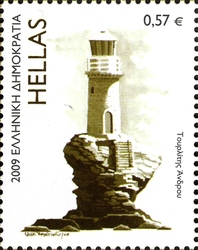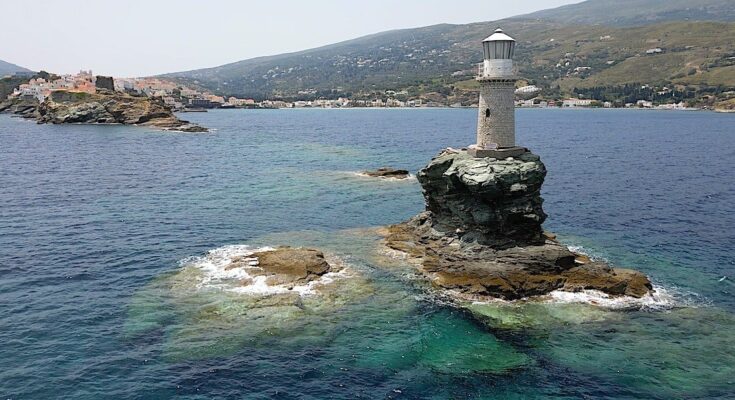Today, on World Lighthouse Day, we celebrate the Tourlitis Lighthouse of Andros, a beacon of Greece’s rich maritime history. This unique lighthouse, perched on a rock in the sea, symbolizes the enduring legacy of the island’s shipping past, reminding us of the vital role lighthouses continue to play in maritime safety and cultural heritage.
On the Aegean island of Andros, Greece, a lighthouse emerging from the water like a strange sea creature is one of the most famous spots on the island.
The Tourlitis lighthouse, which is located at the northernmost extreme of the Cyclades archipelago, has been illuminating the route of seamanship for more than 120 years.
The picturesque and impressive structure is amongst the few in Europe built on a rock in the sea. It was constructed in 1887 and first operated on January 1, 1897. It has a height of seven meters and a focal height of 36 meters with a luminescence of eleven nautical miles.
It was built on a stone column opposite the Venetian Castle of Andros at a time when the island had already become a major center of Greek shipping.
Following the War of Independence, several refugees from the island of Psara arrived there, and their experience in shipping and trade from Central and Eastern Europe made them wealthy and famous worldwide.

Andros Island, the early shipping center of Greece
Andros emerged as a shipping center following the decline of other traditional shipping centers such as Galaxidi and the island of Hydra.
Andrian merchants were particularly active in the grain trade from central and eastern Europe conducted from the Danube estuary.
Initially locally constructed, Andrian ships were later built on Syros, especially as shipping began the transit to steam.
In the twentieth century, Andros, despite the setbacks of the First and Second World War, was at the top of commercial shipping and economic prosperity. In the early twentieth century, Andriot ship owner Dimitris Moraitis launched the Greece – North America sea route. In 1939, Andros was second in number of ship registrations after Piraeus.
The Second World War caused significant losses on the island both in lives and ships. In the late 1950s, a large emigration wave began both to the major urban centers of Athens and Piraeus, as well as abroad (mostly in the USA), reducing the island’s population dramatically.

Andros lighthouse was destroyed and rebuilt
The lighthouse was destroyed during World War II and was never restored in its original form until 1994, when it was rebuilt with funding from the Goulandris family, one of the most prominent families of the island.
It became the first automated lighthouse in Greece, so there was no further need for an onsite keeper to supervise its function.

Since it was renovated, it has been one of the area’s most significant tourist attractions. It also became the first Greek lighthouse to appear on a stamp.
The Global Significance of Lighthouses
As we observe World Lighthouse Day, it’s important to reflect on the global significance of these maritime sentinels. Lighthouses like Tourlitis not only guide ships safely but also serve as cultural landmarks. In recent years, there has been a renewed interest in preserving these structures, recognizing their historical importance and the stories they embody.
- Preservation Efforts: Around the world, efforts are underway to restore and maintain historic lighthouses, ensuring they remain a part of our maritime heritage.
- Tourism and Education: Lighthouses have become popular tourist attractions, educating visitors about their historical role in navigation and offering unique insights into coastal culture.
- Technological Advances: While modern technology has reduced reliance on lighthouses, they remain crucial for navigation in many parts of the world, especially in remote and treacherous waters.



